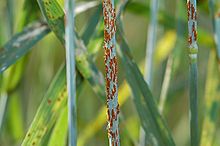| Stem rust | |
|---|---|

| |
| Scientific classification | |
| Domain: | Eukaryota |
| Kingdom: | Fungi |
| Division: | Basidiomycota |
| Class: | Pucciniomycetes |
| Order: | Pucciniales |
| Family: | Pucciniaceae |
| Genus: | Puccinia |
| Species: | P. graminis
|
| Binomial name | |
| Puccinia graminis Pers., (1794)
| |
| Synonyms | |
|
See § Synonyms | |
Stem rust, also known as cereal rust, black rust,[1][2] red rust or red dust,[3] is caused by the fungus Puccinia graminis, which causes significant disease in cereal crops. Crop species that are affected by the disease include bread wheat, durum wheat, barley and triticale.[1] These diseases have affected cereal farming throughout history. The annual recurrence of stem rust of wheat in North Indian plains was discovered by K.C. Mehta.[4] Since the 1950s, wheat strains bred to be resistant to stem rust have become available.[5] Fungicides effective against stem rust are available as well.[6]
In 1999 a new virulent race of stem rust was identified against which most current wheat strains show no resistance. The race was named TTKSK (e.g. isolate Ug99). An epidemic of stem rust on wheat caused by race TTKSK spread across Africa, Asia and the Middle East, causing major concern due to the large numbers of people dependent on wheat for sustenance, thus threatening global food security.[7]
An outbreak of another virulent race of stem rust, TTTTF, took place in Sicily in 2016, suggesting that the disease is returning to Europe.[5] Comprehensive genomic analysis of Puccinia graminis, combined with plant pathology and climate data, has pointed out the potential of the re-emergence of stem wheat rust in UK.[8][9]
- ^ a b Cite error: The named reference
Singh08was invoked but never defined (see the help page). - ^ Cite error: The named reference
Schumann00was invoked but never defined (see the help page). - ^ Cite error: The named reference
vincent2011was invoked but never defined (see the help page). - ^ O, Akhtar. "History". Plant diseases identification. Retrieved 2020-05-31.
- ^ a b Bhattacharya, Shaoni (2017-02-09). "Deadly new wheat disease threatens Europe's crops". Nature. 542 (7640): 145–146. Bibcode:2017Natur.542..145B. doi:10.1038/nature.2017.21424. PMID 28179687. S2CID 4451220.
- ^ Wanyera, R.; Macharia, J. K.; Kilonzo, S. M.; Kamundia, J. W. (2009-08-06). "Foliar Fungicides to Control Wheat Stem Rust, Race TTKS (Ug99), in Kenya". Plant Disease. 93 (9): 929–932. doi:10.1094/PDIS-93-9-0929. PMID 30754537.
- ^ Cite error: The named reference
red alertwas invoked but never defined (see the help page). - ^ Saunders, Diane G. O.; Wulff, Brande B. H.; Thomas, Jane; Fenwick, Paul M.; Visser, Botma; Steffenson, Brian; Singh, Ravi P.; Sela, Hanan; Roohparvar, Ramin (2018-02-08). "Potential for re-emergence of wheat stem rust in the United Kingdom". Communications Biology. 1 (1): 13. doi:10.1038/s42003-018-0013-y. PMC 6053080. PMID 30271900.
- ^ Hovmøller, Mogens S.; Pretorius, Zacharias A.; Saunders, Diane G. O. (2019-02-04). "Tackling the re-emergence of wheat stem rust in Western Europe". Communications Biology. 2 (1): 51. doi:10.1038/s42003-019-0294-9. PMC 6361993. PMID 30729187.